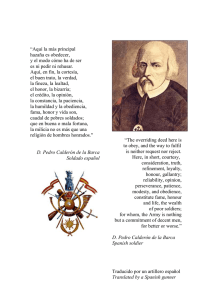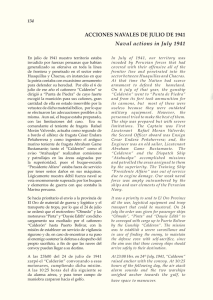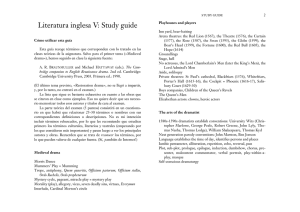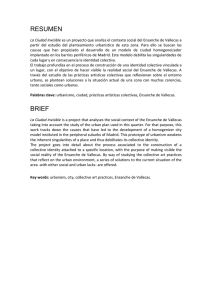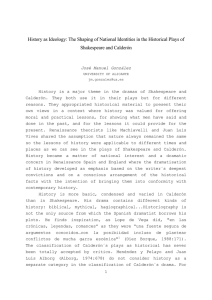The Court Drama of Ben Jonson and Calderón
Anuncio
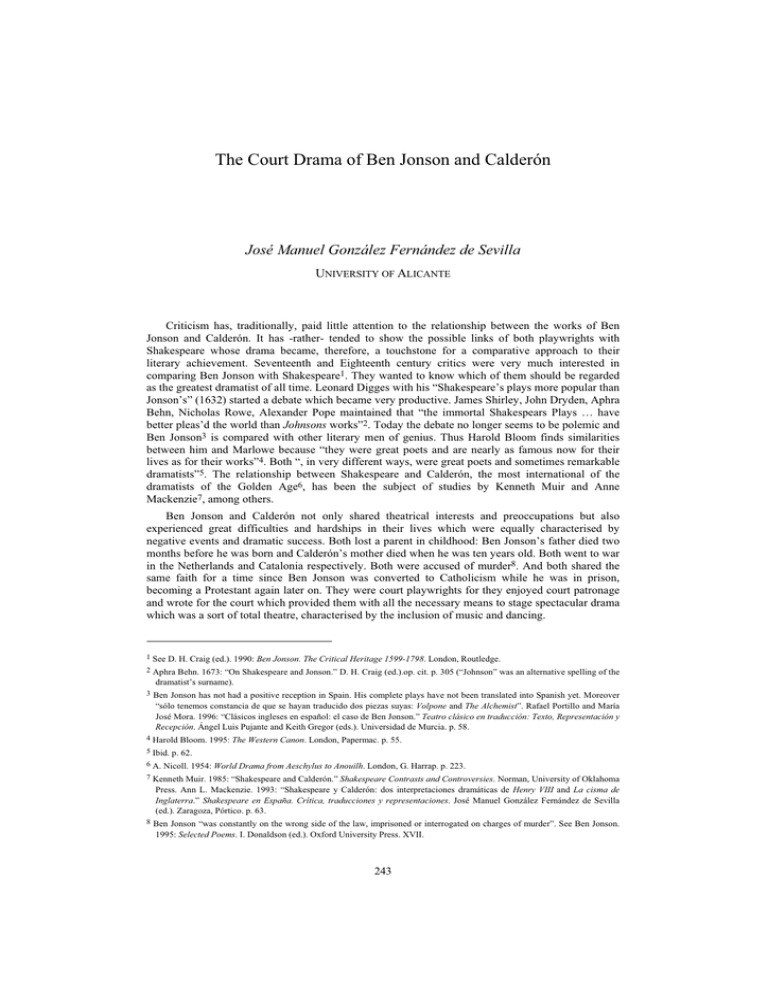
The Court Drama of Ben Jonson and Calderón José Manuel González Fernández de Sevilla UNIVERSITY OF ALICANTE Criticism has, traditionally, paid little attention to the relationship between the works of Ben Jonson and Calderón. It has -rather- tended to show the possible links of both playwrights with Shakespeare whose drama became, therefore, a touchstone for a comparative approach to their literary achievement. Seventeenth and Eighteenth century critics were very much interested in comparing Ben Jonson with Shakespeare1. They wanted to know which of them should be regarded as the greatest dramatist of all time. Leonard Digges with his “Shakespeare’s plays more popular than Jonson’s” (1632) started a debate which became very productive. James Shirley, John Dryden, Aphra Behn, Nicholas Rowe, Alexander Pope maintained that “the immortal Shakespears Plays … have better pleas’d the world than Johnsons works”2. Today the debate no longer seems to be polemic and Ben Jonson3 is compared with other literary men of genius. Thus Harold Bloom finds similarities between him and Marlowe because “they were great poets and are nearly as famous now for their lives as for their works”4. Both “, in very different ways, were great poets and sometimes remarkable dramatists”5. The relationship between Shakespeare and Calderón, the most international of the dramatists of the Golden Age6, has been the subject of studies by Kenneth Muir and Anne Mackenzie7, among others. Ben Jonson and Calderón not only shared theatrical interests and preoccupations but also experienced great difficulties and hardships in their lives which were equally characterised by negative events and dramatic success. Both lost a parent in childhood: Ben Jonson’s father died two months before he was born and Calderón’s mother died when he was ten years old. Both went to war in the Netherlands and Catalonia respectively. Both were accused of murder8. And both shared the same faith for a time since Ben Jonson was converted to Catholicism while he was in prison, becoming a Protestant again later on. They were court playwrights for they enjoyed court patronage and wrote for the court which provided them with all the necessary means to stage spectacular drama which was a sort of total theatre, characterised by the inclusion of music and dancing. 1 See D. H. Craig (ed.). 1990: Ben Jonson. The Critical Heritage 1599-1798. London, Routledge. 2 Aphra Behn. 1673: “On Shakespeare and Jonson.” D. H. Craig (ed.).op. cit. p. 305 (“Johnson” was an alternative spelling of the dramatist’s surname). 3 Ben Jonson has not had a positive reception in Spain. His complete plays have not been translated into Spanish yet. Moreover “sólo tenemos constancia de que se hayan traducido dos piezas suyas: Volpone and The Alchemist”. Rafael Portillo and María José Mora. 1996: “Clásicos ingleses en español: el caso de Ben Jonson.” Teatro clásico en traducción: Texto, Representación y Recepción. Ángel Luis Pujante and Keith Gregor (eds.). Universidad de Murcia. p. 58. 4 Harold Bloom. 1995: The Western Canon. London, Papermac. p. 55. 5 Ibid. p. 62. 6 A. Nicoll. 1954: World Drama from Aeschylus to Anouilh. London, G. Harrap. p. 223. 7 Kenneth Muir. 1985: “Shakespeare and Calderón.” Shakespeare Contrasts and Controversies. Norman, University of Oklahoma Press. Ann L. Mackenzie. 1993: “Shakespeare y Calderón: dos interpretaciones dramáticas de Henry VIII and La cisma de Inglaterra.” Shakespeare en España. Crítica, traducciones y representaciones. José Manuel González Fernández de Sevilla (ed.). Zaragoza, Pórtico. p. 63. 8 Ben Jonson “was constantly on the wrong side of the law, imprisoned or interrogated on charges of murder”. See Ben Jonson. 1995: Selected Poems. I. Donaldson (ed.). Oxford University Press. XVII. 243 244 JOSÉ MANUEL GONZÁLEZ FERNÁNDEZ DE SEVILLA Court drama grew out of popular drama. That is why -sometimes- it is difficult to distinguish themes and conventions between them, though the length of the court performances was far greater than that of the popular drama. Court plays meant a revolution in theatrical possibilities. They were part of an explosion of spectacular court entertainment in England, Spain and France. New theatres, places and décor were needed to perform the court plays which became a new dramatic genre combining drama with the visual and aural arts. Mythology and ancient history played an important role because the characters represented mythological heroes, demigods, princes of antiquity and the performances might also refer to legends and myths. It was a kind of “platonic theatre”9 where virtues and abstract entities represented different values and ideals. The setting was sophisticated and relied heavily on profuse décor and spectacle, -the very essence of court drama. Music and songs contributed greatly to the overall effect of these performances. Thus Calderón’s court plays became associated with the rise of zarzuela, and El jardín de Falerina (1648) is believed to be the first zarzuela to be written and produced in Spain. The autos sacramentales also incorporated spectacular elements similar to those of the court drama for “los desarrollos escenográficos en su fastuosidad y barroquismo son análogos … “, although “El valor simbólico y religioso sustituye en el auto al valor estético del teatro palaciego”10 Ben Jonson appears to be “a writer of power and intelligence”11 in the masques. He created this particular type of drama specially to entertain the English court. There had been primitive courtentertainments before like “mummings” or “disguinings” which developed into masques later in the 16th century. Jonson in collaboration with Inigo Jones gave them a characteristic shape and style. The masque, with an elementary dramatic pattern and great theatrical elaboration, became fashionable when Entertainment at Althorpe won royal attention. These productions were performed at Christmas and the household participated in their staging though speaking parts were reserved for the professional players. Women took part in the masques which came to be a fashion show for “The first and most important element of the masque was the practice of dressing up and showing off.”12. These representations required elaborate and costly machinery. They had a political significance because they had been devised to glorify the king, reinforcing his absolute power. They became an instrument for royal propaganda since the king was “the essential point of reference … “13. This political potential is seen in most of the masques where the king was the central figure and the expression of absolutist rule. He personified wisdom, beauty, virtue and power, representing the principle of harmony and order. The illusory world of the masques incorporated the world of James I, who, in this way, became not only the ethical but also the physical and emblematic centre of the performance14 where he was also “silent text”15. This is made clear in The Masque of Oberon, the Fairy Prince, when Oberon appeared in a chariot drawn by two bears at the end of the masque: Melt earth to sea, sea flow to air And air fly into fire, Whilst we in tunes to Arthur’s chair Bear Oberon’s desire; Than which there can be nothing higher, 9 Alhough G. Parry uses this term to describe the masques, we believe that can also referred to any kind of court drama representation. Graham Parry. 1989: The Seventeenth Century. The Cultural and Intellectual Context of English Literature 1603-1660. London, Longman. p. 17. 10 Ignacio Arellano. 1995: Historia del teatro español del siglo XVII. Madrid, Cátedra. p. 98. 11 T.S. Eliot. (1980): “Ben Jonson.”, Selected Essays. London, Faber. p. 156. 12 Robert M. Adams. 1979: Ben Jonson’s Plays and Masques. New York, W.W. Norton. p. 315. 13 G. Parry. op. cit. p. 17. 14 Barbara Kiefer Lewalski. 1993: Writing Women in Jacobean England. Cambridge, Mass., Harvard University Press. p. 28. 15 J. Goldberg in Jerzy Limon. 1986: Dangerous Matter. English Drama and Politics 1623-1624. Cambridge University Press. p. 26. Sederi VIII (1997) THE COURT DRAMA OF BEN JONSON AND CALDERÓN 245 Save JAMES, to whom it flies: But he the wonder is of tongues, of ears, of eyes. (190-196) Thus “Text and monarch stood in the same relationship to the performance onstage”16. The four elements were also present to emphasize the greatness of such a king who was as necessary and substantial for his people. There was a mythic idealization and glorification of James who, seated in his chair of state, controlled the entire spectacle. However his appraisal of kingship is stronger and more explicit: A night of homage to the British court, And ceremony, due to Arthur’s chair From our bright master, Oberon the fair; Who, with these knights attendants, here preserved In Faery land, for good they had deserved Of yon high throne are come of right to pay Their annual vows, and all their glories lay At’s feet, and tender to this only great True majesty, restoréd in this seat; (207-215) The panegyric tone of these lines justifies the supreme power of the English monarchy since the king was appointed supreme ruler and was seated on Arthur’s chair that was expected to be taken by Henry, the Faery Prince, in the future. And all the masquers, including Oberon, Sylvans, Satyrs, and Silenus showed their respect for their king, turning their attention to his throne where he was sat in the front of the audience, playing a twofold role for he was actor and king at the same time. Moreover his acting skill was not only shown in the theatre but also in all public appearances and official events where he was expected to follow complex rules of protocol with great ceremony. Thus the monarch became a relevant figure in social life as well as in the theatre because he was the ruler not only of the real world but also of the illusionary world. The king himself was also an important part of the audience because he was spectator of what was going on on the stage. So we get, as Stephen Orgel mentions, two kinds of audiences attending a court spectacle: “the king watching the play, and the remainder of the audience watching the king ‘at a play`”17. In this way the theatrical potential of monarchy was fully achieved for the king “was both spectator and spectacle”18, so that the English and the Spanish courts became “ … a sort of theatre production … “19, which was basically intended to enhance the power of the king’s image through spectacular visualization in order to make the king the focal point of political and cultural life. The court was a decisive element in the development of Calderon’s drama which reflects court interests and expectations at a time when Spanish drama was “ … ante todo, un instrumento político y social”20 and theatre was thought as “una gran compañía de propaganda social, destinada a difundir y fortalecer los intereses de la monarquía”21. The influence of the Spanish court was stronger on the plays of the second part of his dramatic career, those that were written after taking holy orders, when he was completely devoted to writing “autos sacramentales” and court drama which should be regarded within “la problemática de la coyuntura política y cortesana a la que pertenecen”. It means that they also included “las dimensiones panegíricas, celebrativas de la realeza … “22 as we can see 16 Ibid. 17 Stephen Orgel. 1975: The Illusion of Power: Political Theater in the English Renaissance. Berkeley, University of California Press. p. 9. 18 D. Fox.1986: Kings in Calderón: A Study of Characterisation and Political Theory. London, Támesis books Ltd. p. 3. 19 Margaret Rich Greer. 1991: The Play of Power. Mythological Court Dramas of Calderón. Princeton Univerity Press. p. 13. 20 José Antonio Maravall. 1980: Teatro y Literatura en la sociedad barroca. Barcelona, Crítica. p. 19. 21 Ibid. p. 22. 22 Sebastian Neumeister vindicates again “la necesidad de recontextualizar estas comedias [obras cortesanas]” to come to know their real significance and purpose. See Ignacio Arellano. op. cit. p. 507. Sederi VIII (1997) 246 JOSÉ MANUEL GONZÁLEZ FERNÁNDEZ DE SEVILLA in the “autos sacramentales” which showed a political concern in a subtle way. It is precisely the king in El gran teatro del mundo who refers to imperial authority: A mi dilatado imperio estrecho límites son cuántas contiene provincias esta máquina inferior. De cuanto circunda el mar y de cuanto alumbra el sol soy el absoluto dueño, soy el supremo señor. Los vasallos de mi imperio se postran por donde voy ¿Qué he menester yo en el mundo?23 Royal power has no limits. Besides the king is seen as the giver of life and death because of his divine origin. He is God’s representative upon earth and his Godlike condition means control over all the world. Calderón’s mythological court plays exhibit a greater political interest because, as Menéndez Pelayo points out, they were “plays of power”24 in the sense that they had a propagandistic intention to celebrate kingship as the essential principle to preserve the Spanish social order. These plays, as in the Spanish comedia, contributed “también mediante la espectacularidad, a esta progaganda real … “. Moreover “a la técnica repetida de enmascarar la realidad cotidiana [se sumaba], como consecuencia de la intocabilidad del rey, una difusión de la ideologia”25. And mythology was frequently used in these plays to satisfy “ … the humanists’desire to revive a classical world and the rulers’interest in legitimizing power … “26. Yet these court performances included “if not loyal opposition, at least loyal criticism”27, as a result of the noteworthy freedom of expression which Spain enjoyed during the reign of Philip IV when monarchy was “la condición sine qua non de la existencia social”28. Drama, therefore, was used as a vehicle of political consciousness and reflected a keen awareness of the tensions and preoccupations which people suffered at a time of abuse of power. So we come across a provocative element in these plays since they were intended to be a dramatic protest against absolute authority and the growing degradation of monarchy. Calderón’s drama tried to be critical, voicing his concern and pessimism about the political situation, but this was done “coating the criticism with generous doses of humour and spectacular brilliance”29. And the critical appreciation of the incongruencies of power was very much present in the mythological court plays which became a valuable instrument for royal opposition expressed through classical myths in a subtle and uncompromising manner, encapsulating new messages about the management of government. It meant the possibility of thinking about new forms of power without attacking the legitimate authority. Hercules at the opening of Fieras afemina amor has to fight with a lion which could be a metaphor of tyrannical power since tyrants behave like lions that terrify people. They could be like animals which try to get everything from their victims using physical force to threaten them. The topic of tyranny is also discussed in La gran Cenobia and La torre de Babilonia, 23 Calderón de la Barca. 1957: “El gran teatro del mundo.” Obras completas. Ángel Valbuena Prat (ed.). Madrid, Aguilar. vol. III. p. 213. 24 See Margaret Rich Greer. op. cit. p. 7. 25 José María Díez Borque. 1976: Sociología de la comedia española del siglo XVII. Madrid, Cátedra. p. 131. 26 Margaret Rich Greer. op. cit. p. 10. 27 Margaret Rich Greer. op. cit. p. 3. 28 José María Díez Borque. op. cit. p. 129. 29 Margaret Rich Greer. op. cit. p. 94. Sederi VIII (1997) THE COURT DRAMA OF BEN JONSON AND CALDERÓN 247 where Aureliano and Nembrotabuse power through both imposition and terror30. However El hijo del sol, Faetón presents a more complex criticism of Spanish politics when Faetón asks Apollo to fulfil his dreams: Pues déjame que tu carro hoy rija, para que triunfe tan de todos de una vez que todos de mí se alumbren. Galatea, Amaltea y Tetis vean (puesto que traslucen las deidades, de tu alcázar las más lejanas vislumbres) que hijo tuyo me acredita tu mismo esplendor, y suple tu persona la mía.31 And this is going to be Faetón’s tragic end. He ascended into heaven to be allowed to drive the chariot of the sun for a single day but, once he got permission and set off, was entirely unable to control the horses, crying in despair “y pues ardo yo, arda todo!”. This could be the case of Spanish policy in the hands of the king’s favourites who, like Faetón, tried to get power at any cost. However, as the text suggests, it was not their fault but the king’s who allowed them to have all power and make decisions. Apollo should not have permitted Faetón to do so since driving the chariot was his entire responsibility. Thus “Calderón parece estar advirtiendo también en esta tragedia mitológica que el celeste auriga nunca debe ceder ni abandonar del todo las decisivas riendas del carro …, y que tampoco nunca debe subir a él quién vaya pensando en deportivas carreras placenteras …”32. Calderón’s royal criticism reaches its peak in Céfalo y Pocris where the figure of the king is ridiculed and satirized33. This musical comedy was presented before the king, as part of the Shrovetide entertainments which gave a festive tone to the whole performance. There is a dramatic subversion of values through the appearance of grotesque and absurd elements as a consequence of the chaotic state of the world where the character of the monarch is distorted and degraded. This is the reason why the play is “un texto insólito por su significación en la dramaturgia barroca”34. Royal language is also devalued because the king does not keep the formal register as it should be and the versification is rude and unpolished: Vasallos, deudos y amigos, cuya lealtad y virtud canta el sol por fa, mi, ré, 30 Calderón showed his concern with power in his early plays as we can see in Amor, Honor y Poder where “El choque entre el individuo y el Poder o la autoridad y su abuso” are dramatised. José Alcalá-Zamora. 1988: “Mitos y política en la España del joven Calderón.” El mito en el teatro clásico español. Francisco Ruíz Ramón y César Oliva (eds.). Madrid, Taurus. p. 139. 31 Calderón de la Barca. 1966 “El hijo del sol, Faetón.” Obras completas. Ángel Valbuena Briones (ed.). Madrid, Aguilar. vol. 1. p. 1897. 32 Alberto Navarro González. 1984: Calderón de la Barca de lo trágico a lo grotesco. Univ. de Salamanca. p. 40. 33 Calderón’s theatre dramatises the negative qualities of rulers which are also characterised by their follies and passions. Henry VIII (La cisma de Inglaterra), Semíramis (La hija del aire) and David (Los cabellos de Absalón) show the human side of rulers. However we should bear in mind that “Whatever its tone, Calderón’s dialectical drama expresses an absolute faith in the power of virtue”. This is why there are unquestionably exemplary kings in his plays. El príncipe constante and El Santo Rey Don Fernando “confirm the qualities of superior rulership and provide a set of principles with which to evaluate other historical kings in Calderón.” D. Fox. op. cit. pp. 116, 21. 34 Juan Antonio Hormigón. 1988: “Los mitos en el espejo cóncavo: transgresiones de la norma en el personaje del rey.” El mito en el teatro clásico español. Francisco Ruiz Ramón y César Oliva (eds.). Madrid, Taurus. p. 176. Sederi VIII (1997) 248 JOSÉ MANUEL GONZÁLEZ FERNÁNDEZ DE SEVILLA la fama por cefaut … Pero ya que la fortuna, deidad sin consejo algún, ha dispuesto los acasos de suerte, que ese avestruz dirigió a mi hijo, quedando tendido como un atún … … Pero tente, lengua que en lo infiel eres Dragut35. Words are no longer meaningful because they are abused in order to present a rotten world where kingship has lost its verbal credit and conviction. Words are not presented for their textual significance but as a pretext for linguistic nonsense. The protocol which is expected to be followed in rituals and ceremonies is not used because formalities are ridiculed as in the king’s hand-kissing scene. Moreover the king does not care much about his royal duties leaving his office unattended since he is completely devoted to the preparation of his daughters’ marriages, as he manifests that “Es más de que pide el pueblo que estas dos hijas doncellas es hora que salgan deste San Juan de la penitencia, a tomar estado?”. The monarch seems unfit to hold office because he wants to get rid of any public responsibility. He is quite determined not to practise virtue any more: Pues ando rotivestido andar quiero manirroto con vos; y auque el ser, creed, piadoso, es virtud moral, hoy quiero hacerla peral … y dando al amor tributo, vaya el diablo para puto y casaos con una dellas36. The devil becomes the reference for royal actions and decisions. The king’s divine calling is reversed and tragically changed into a nightmare which is not dramatically consistent for explaining such strange deeds and behaviours as in the episode of the prince’s death when the king is congratulated at the news of the prince’s eternal departure. All this theatrical illusion is not only explained by the festive context where all liberties were allowed and everybody, the king included, could be criticized and mocked but also as an attempt to demistify royal power as such. However this opposition to monarchy through court plays was stronger and more subversive in England than in Spain because “The Jacobean establishment had not one but three centers of power, with the courts of Queen Anne, and later Prince Henry standing in some oppositional tension vis-àvis the King’s court”37. The divided court and the succession of male favourites made the English court a focus of potential disorder and scandal as the poet John Harington reflected when he wrote “I neer did see such lack of good order, discretion, and sobriety, as I have now done … “38. And court drama productions also contributed to this atmosphere of opposition and subversion. Queen Anne herself was directly responsible for subversive actions in court performances since she used masques to intervene in diplomatic politics showing her support for particular interests, as could be seen in her overt pro-Spanish policy. Moreover we should bear in mind that Ben Jonson’s first masques were designed to please the Queen and her household trying to threaten male power personified in the 35 Pedro Calderón de la Barca. 1979: Céfalo y Pocris. Alberto Navarro (ed.). Salamanca, Almar. pp. 58-62. 36 Ibid. p. 95. 37 Barbara Kiefer Lewalski. op. cit. p. 15. 38 John Harington. 1930: The Letters and Epigrams of Sir John Harington. Norman E. McClure (ed.). Philadelphia, University of Pennsylvania Press. p. 120. Sederi VIII (1997) THE COURT DRAMA OF BEN JONSON AND CALDERÓN 249 King as in the Masque of Blacknesse where the Queen and her ladies represented black African beauties whose colour, wildness and exoticism could not be transformed by the whiteness of Albion (James I) in spite of their visit to England where they were supposed to change their black skins into white ones. This time the beams of the Sun-King of Britannia were unable “To blanch an Aethiope … and salve the rude defects of every creature” (255-257). Unfortunately James’s powers were not sufficiently displayed for the Ethiops remained black at the end of the masque! Besides the Queen, who took the role of Aethipia, recalled Queen Elizabeth as Cynthia, “reinforcing the association of these ladies with female danger and power.”39s Similar ideas and expectations were developed in its sequel, The Masque of Beautie, presented on January 10, 1608. Once more the Queen appeared to control the whole action of the dramatic performance whose subtext reinforced women’s power since female beauty and sexuality meant a real threat to the norms of James’s court, characterised by misogyny and male values. One of its final songs made strong claims for female authority: Had those, that dwell in error foule, And hold that women have no soule, But seene these move: they would have, then, Said, Women were the soules of men. So they doe move each heart, and eye With the world’s soule, true harmony. (368-373) Finally all female characters, the Queen included, who, in this occasion, represented Harmonia, were invited to stay in Britain for ever because they could be agents of national transformation. But the masques directed against particular actions showed a stronger opposition to royal policy for they had a negative effect on public matters. Neptune’s Triumph for the Return of Albion (1624), a censored version by the king of the original text, dealt with the political consequences of the failure of the Spanish Match promoted by James I for he was accused of negligence for sending Prince Charles to Spain to marry the Spanish Infanta. As some thought that would have been a serious mistake which could have endangered the future of England, Ben Jonson’s masque was an attempt to free the king from all blame and to make clear that, It was no enuious Stepdames rage; Or Tyrants malice of the age, That did emply him forth. But such a Wisdome, that would proue, By sending him, their hearts, and loue, That else might feare his worth. (355-360) The text is intended to be a dramatic defence of the king’s political intention which had been very much questioned. He tried to justify his policy as a way of testing the true nature of Spaniards on the one hand, and as revealing the falsehood of Spain on the other. But his presentation as Neptune and loving father, who missed his son and tried to rescue him, was a theatrical show which confirmed royal failure in this particular matter. Court plays were not only sophisticated spectacles. They were also intended to oppose particular forms of power which contradicted new expectations. They had a political dimension for they were concerned with the abuse of royal authority. And their criticism was radical because it was expressed in the court by playwrights who owed their literary promotion to the king. Moreover they had a metatheatrical potential since they tried to make English and Spanish audiences aware of the necessity of changes in the management and control of power at a time of crisis and doubts. 39 Barbara Kiefer Lewalski. op. cit. p. 33. Sederi VIII (1997) 250 JOSÉ MANUEL GONZÁLEZ FERNÁNDEZ DE SEVILLA BIBLIOGRAPHY Arellano, Ignacio. 1995: Historia del teatro español del siglo XVII. Madrid, Cátedra. Burt, R. 1993: Licensed by Authority. Ben Jonson and the Dis courses of Censorship. Ithaca, Cornell U.P. Calderón de la Barca, Pedro. 1966: Obras completas. Ángel Valbuena Briones (ed.). Madrid, Aguilar. Tomo I. ------. 1967: Obras completas. Ángel Valbuena Prats (ed.). Madrid, Aguilar. Tomo III. ------. 1979: Céfalo y Pocris. Alberto Navarro (ed.). Salamanca, Almar. Craig, D.H. 1990: Ben Jonson: The Critical Heritag 1599-1798. London, Routledge. Díez Borque, José María. 1976: Sociología de la comedia española del siglo XVII. Madrid, Cátedra. ------. 1988: El teatro en el siglo XVII. Madrid, Taurus, 1988. Eliot, T.S. (1980): Selected Essays. London, Faber. Fox, D. 1986: Kings in Calderón: A Study of Characterisation and Political Theory. London, Támesis Books. Greer, Margaret. 1991: The Play of Power. Mythological Court Dramas of Calderón. Princeton U.P. Haynes, Jonathan. 1992: The Social Relations of Jonson’s Theatre. Cambridge U.P. Jonson, Ben. 1979: Plays and Masques. R.M. Adams (ed.). New York, W.W. Norton. Jerzy, Limon. 1986: Dangerous Matter. English Drama and Politics 1623-1624. Cambridge U.P. Legatt, Alexander. 1981 Ben Jonson. His Vision and His Art. London, Methuen. ------. 1988. English Drama: Shakespeare to the Restoration. London, Longman. Lewalski, Barbara K. 1993: Writing Women in Jacobean England. Cambridge, Mass. Harvard U.P. Maravall, José Antonio. 1990: Teatro y Literatura en la sociedad barroca. Barcelona, Crítica. Navarro González, Alberto. 1984: Calderón de la Barca. De lo trágico a lo grotesco. Universidad de Salamanca. Orgel, S. 1975: The Illusion of Power: Political Theatre in the English Reanissance. Berkeley, California U.P. Parry, G. 1989: The Seventeenth Century, London, Longman. Rodríguez Evangelina and Antonio Tordera. 1983: Calderón y la obra dramática del siglo XVII. London, Támesis Books. Ruíz Ramón, Francisco and César Oliva (eds.). 1988: El mito en el teatro clásico español. Madrid, Taurus. *** Sederi VIII (1997)
